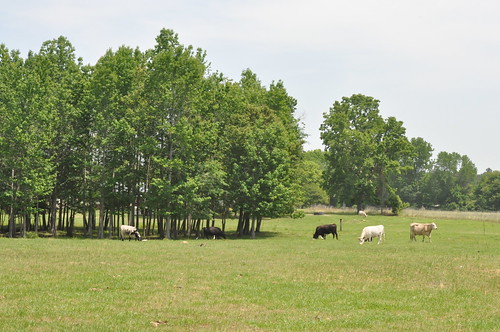
Lifelong farmer Hezekiah Gibson, and his wife Frances, farm 1,200 acres in Manning, South Carolina. They have been working with USDA’s Natural Resources Conservation Service (NRCS) for years to improve conservation on their farm.
In 2013, the couple’s non-profit organization, United Farmers USA―dedicated to helping small farmers succeed through a wide range of outreach and technical assistance, educational programs and resources―received an NRCS Conservation Innovation Grant (CIG). These grants help NRCS support public and private entities to accelerate technology transfer and adoption of promising technologies and approaches to address some of the Nation's most pressing natural resource concerns.
Through their CIG project, the Gibsons have implemented a silvopasture demonstration area on their farm, and have educated other farmers on the benefits.
Silvopasture―the practice of combining forestry and the grazing of livestock―benefits timber, forage, and livestock production by allowing both practices on the same acreage, at the same time. It not only improves the appearance of the landowner’s property, it helps the livestock and environment too.
During the summer months, tree canopies provide shelter to livestock from heat and inclement weather. The Gibsons say silvopasture helps their livestock maintain body weight in the hotter months by continuing to graze during the day in the shade, as opposed to grazing only at night in open pasture when it’s cooler.
“Silvopasture is a win-win situation, as you can have value added attributes, such as baling and selling hay, or cutting trees for timber,” said Hezekiah.
Silvopasture is not new to the Gibsons. They have been using this conservation practice for years and have 120 acres in silvopasture. When managed properly silvopasture can help farming operations become more sustainable by increasing annual revenues and providing better use of forest lands.
They have also implemented several conservation practices on their farm, including fencing and cross-fencing 300 acres of pasture, which allows them to practice rotational grazing for their livestock. By using rotational grazing―moving cows to different pastures before it can be overgrazed―herd health is increased, soil erosion is reduced, and soil and forage health is greatly improved.
Through CIG funding, the Gibsons have hosted many two-hour classes, educational workshops, and demonstration tours for historically underserved landowners. Additional demonstration sites will be established in the Low country, Savannah, Pee Dee, and Coastal Plain areas to reach more farmers in USDA StrikeForce areas.
USDA StrikeForce teams operate in 880 counties in 21 states and Puerto Rico and provide opportunities for NRCS to work with underserved landowners to determine how best to leverage available financial assistance and address natural resource concerns—with an emphasis on historically underserved communities in rural counties that have consistently high poverty.
Farmers interested in learning more about Conservation Innovation Grants or land management practices should visit www.nrcs.usda.gov/GetStarted or a local USDA service center.
NOTE: For an interactive look at USDA's work in conservation and forestry over the course of this Administration, visit http://medium.com/usda-results.



